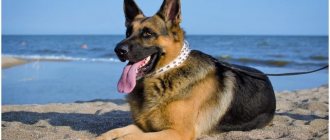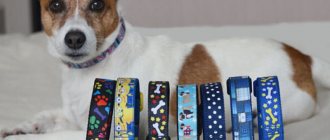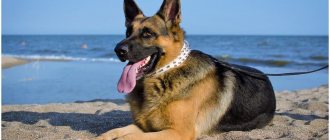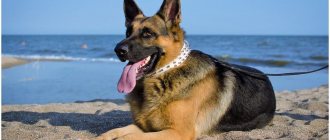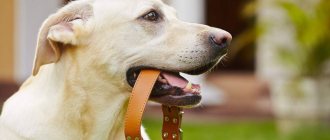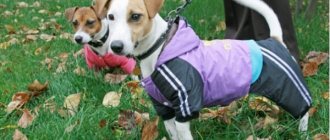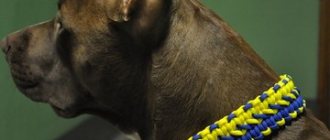A strict collar for dogs (photo below) or parfors is one of the most popular and convenient means of controlling an animal, which makes it relatively easy to correct unwanted behavior.
This training accessory has both its supporters and those who categorically object to its use.
Operating principle
Parfors for dogs consists of metal plates with spikes, which are assembled into a chain. The spikes are rounded, they do not injure the dog or cause serious damage to the skin - they are softened by the fur. The collar combines a ring, and a leash is attached to a second identical ring. If the dog is in a calm state - sitting, lying down, walking next to the owner on a leash - the handler lies on the neck, like a regular collar. If the animal tries to jerk the leash sharply, the collar becomes tense and the spikes cause pain. As soon as the dog takes a calm position again, the discomfort stops.
Typically, a planer is an accessory for large dogs that do not want to obey the owner, are ill-mannered or pose a threat. Similar products in small sizes for puppies and small breeds are simply not produced. The opinions of dog handlers on the need for a planer vary - some experts argue that it is a necessary tool for correcting behavior, others that it is a last resort. In any case, you should only wear it during training sessions and take it off in all other situations.
Spikes don't hurt your dog
Types of parfors
There are several types of parfors for dogs:
- with short spines;
- wire models;
- plate type collars;
- with long spines.
Collar for dogs and puppies: types, how to choose
There are also many safety collars that are made from different materials and with different types of coatings.
Note! Today, the most popular is the German-type scalloped parfors with a fabric insert on the outside. The main advantage of this accessory is that it is equipped with detachable mechanisms in the form of a carabiner.
Main functions
A dog groomer performs two functions: it corrects behavior and teaches commands. In any case, wearing it should be combined with voice commands and careful observation of the animal’s behavior. You can use the product while walking or during training with a dog handler.
During a walk, the planer is used to suppress the animal’s aggression and develop the habit of obedience to the owner. The main task is to prevent attempts to pull on the leash. A dog walking in a parforce will feel comfortable only when it calmly walks next to the owner or runs away to the permitted length of the leash.
If a dog exhibits inappropriate behavior - barks at passers-by, tries to run away and drag a person along with it, the collar immediately causes him discomfort.
In this case, the owner should not passively observe how the dog behaves. By his actions, he must indicate the inadmissibility of her behavior - say “no”, pull the leash towards himself. If the owner understands his animal's behavior well, he can give such signals in advance. As a result, the pet learns to obey. Important! In packs of dogs, a bite on the neck is a kind of punishment from individuals occupying a higher position.
For the animal, this is a signal that its behavior is not approved by a stronger animal, and it needs to be stopped. The pressure of the planer's spines on the neck imitates such a bite. If a dog collar is needed to teach the animal certain commands, then it is worn only during training. The owner holds the leash, gives a command, and if the dog does not comply, he pulls it towards himself. An important component is that the owner must make the animal understand what he wants from him, and only then apply strict measures. The effect is the same as in the case of a walk. A dog is comfortable only when it obeys, and uncomfortable when it disobeys.
The main thing that the owner needs to understand before using such equipment is that a strict collar for a dog is a temporary solution. He develops the habit of obeying, but the owner himself must maintain it. That is, the goal of training is to motivate the dog to obey, regardless of whether he is wearing a handler, a regular collar, or no equipment at all.
And this collar is decorative
What are they?
A strict collar for dogs (the photo will give you a first impression) is a high-quality and irreplaceable assistant and a very effective educational accessory. It is widely used in training. Particularly popular are studded parfors of the plate or wire type. If you have a long-haired dog, then the plate type will not work. The main disadvantage is the difficulty of pulling out the links. Wire models are most often equipped with special chains, which greatly facilitates their use. The peculiarity is that the teeth are located perpendicularly. This provides the desired effect, but the teeth do not scratch or injure the skin. You don't want to treat your dog after training.
How to choose the right collar
You need to choose a handler for dogs so that it has an educational effect, but does not cause injury. It should be the right size, just like a regular collar. If the parforce is tight, the dog may suffocate; if it is too loose, there will be no discomfort due to illegal behavior.
Before deciding to make such a purchase, it is better to consult with a professional dog handler, because a strict collar is not just an accessory, but a tool comparable in importance only to medical or veterinary equipment.
Types of parfors
Parfors are divided into several categories. By weight they are light, medium and heavy. Which one to choose depends on the personal characteristics of the animal and its weight. Light ones are recommended for animals weighing less than 13 kg, medium ones - from 13 to 25 kg, and heavy ones - for large dogs weighing more than 25 kg.
Important! The collar may cause skin irritation. Its causes include wearing it too long, unsuitable spikes, thin hair or sensitive skin on the dog.
According to their structure, parfors are divided into wire, chain and plate. The wire is suitable for long-haired dogs - hairs do not get stuck in it, and the animal does not experience additional discomfort. Metal plates, on the contrary, are needed for short-haired breeds. If the coat is of medium length, like a German Shepherd, it needs a collar made of wire.
Electronic version of the product
What to look for when buying parforce for dogs, and what it gives:
- Size and weight (best to try on in advance).
- The length of the spikes must correspond to the breed.
- The location of the spikes is all over the neck or just in front. It is believed that the spines in the Adam's apple area imitate the bite of another dog.
- The presence of a detachable mechanism makes it possible to quickly put on and remove the collar, and the pet will not be able to remove models without it on its own.
- Comfortable or uncomfortable attachment for a leash.
- Appearance is a matter of convenience for the owners, as well as the ability to disguise the parfors as an ordinary accessory.
The age, breed, and size of the dog matter. It is best to come to the store with your pet and have a fitting.
Size
A correctly selected attribute should lie relatively freely on the neck. In a calm state, the spikes touch the animal’s neck, and the chain lies on them. The dog does not show anxiety, does not whine or growl at the new equipment. At the same time, the collar cannot be removed over the head. You can stick a finger between the back, where there are no spikes, and the neck.
To check that the fit is correct, you need to lightly pull the collar at the front - the space for a finger at the back will immediately disappear. This means that the parforce will stretch when the leash is pulled. Do not pull on the back to check so that the spikes dig into the neck.
Spikes
The length of the spikes directly depends on the length and thickness of the coat. The coat is the dog’s natural protection from adverse factors, including mechanical injuries. The most popular collar - for a shepherd dog - is equipped with medium-length spikes. Versions for short-haired animals should be equipped with short protrusions with rubberized tips, and for long-haired animals, on the contrary, long ones with metal rounded spikes.
"Strogach" imitates the bite of the leader of the pack
Important! Spikes should never be sharp! Using a planer should not injure the dog. If the collar is chosen incorrectly and the dog suffers, you should immediately stop training, discard the existing collar and replace it with a more suitable one.
Tips for choosing
Size
Measure the volume of your pet's neck slightly below the auricle. Select the diameter of the parfors to be 5 cm larger than the girth.
Spikes length
The length of the spiked tips varies from 2 to 5 cm depending on weight, height and breed. For example, for thick-haired animals it is necessary to purchase a model with spikes of 4-5 cm, and for smooth-haired animals - no more than 2 cm. Currently, parfors with spurs with rubberized ends have become popular.
Material
The most common materials are stainless steel and galvanized metal. Often rubber, leather or thick fabric is added to it to soften the effect.
Rules for using the planer
A strict collar is a temporary part of a dog’s equipment. You can wear it for no more than an hour. This will save the dog from injuries and skin irritation and increase the educational effect. If the parfors is used for a walk, it is worn as an additional collar. For example, on the way to the dog playground, the leash is attached to the leash to stop aggression, and on the playground it is removed so that the pet can calmly play with other animals.
The second rule is that the collar is designed for quick correction, and not for strict control. In order for the dog to receive the correct signal, jerks on the leash should be short and sharp. You cannot constantly pull on the leash.
Peculiarities
The collar is the most important attribute of dog equipment. A strict collar or, as it is also called, a stricter or parfors, is used during training of pets that do not perceive commands well, and also refuse to carry them out and often ignore their owner. A properly selected high-quality collar is a humane element for training a disobedient dog , which is absolutely safe for your pet.
How to put a collar on a dog
A collar without a detachable mechanism should be put on as follows:
- Turn the spikes out.
- Pull it over the dog's head.
- Turn into the correct position - with the spikes facing in.
- Adjust the position so that the product does not put pressure on the neck when at rest.
If there is a detachable mechanism, then the procedure is much simpler - disconnect the carabiner, and then snap it onto the dog’s neck. The process should be accompanied by stroking, because putting on a collar in itself is not a punishment.
Weasel is the main educational tool
Popular manufacturers
The most common brands are:
- Darell;
- Trixie;
- Sprenger;
- VIPet;
- Triol;
- Yami-Yami;
- Rogz;
- Ferplast Chrome.
Rogz
VIPet Use a strict collar only if all other methods do not work and the animal can only be trained using strict measures. Be patient and believe in your own success. Consult an experienced trainer or dog handler in advance.
How to train a dog with a collar: basic rules
The rules of training are the same as for regular training, only one new element is added - the dog will be punished for inappropriate behavior. The trainer's main tools are an iron will and rewarding the animal for correctly following commands. The algorithm of actions is as follows:
- The owner or trainer gives the command.
- At the same time, he uses gestures to indicate to the dog what needs to be done (for example, “sit” - pressing on the sacrum, and “lying” - on the withers).
- If the pet at least approximately follows the command, he receives a reward - this way he will remember what to do.
- If the animal is stubborn, plays around, or refuses to exercise, the owner gives a short tug on the leash. The spikes imitate a bite on the neck - this is how dogs in a pack demonstrate that they are dissatisfied with the behavior of a relative.
Even the presence of a planer does not cancel the reward for the correct execution of commands. Gradually, the parfors is abandoned, replaced with a bridle, and then with an ordinary collar. Some dog trainers are against such harsh measures and believe that an associative connection between training and pain cannot be established.
Important! The goal of training is to ensure that the dog follows commands without parforce. If the pet is forced to obey only the fear of punishment, then serious mistakes have been made in training.
What it is?
This is a metal chain that consists of large links. On one side there are spikes, and on the other it is smooth. You can use both during training. Of course, the spiked side is only needed to practice certain skills. The rest of the time you can safely change it to smooth. In everyday life, you can very often see an owner running after his dog, pulling on the leash with the strength of a young horse. To prevent this from happening to you, you need to use the right methods in training.
Is it possible to use a collar for puppies?
All dog handlers are clear on this – it’s impossible. Even if the puppy is a shepherd dog, Labrador, pit bull or another breed that requires careful attention from the owners. A strict collar is only worn on adult dogs.
Puppies can wear only these collars
A strict collar is a useful piece of equipment, but it is better to wear it under the supervision of a canine specialist. We must not forget that the main tools for training a dog are affection, attention and care, and punishment should be used only as a last resort.
A good weapon in capable hands
It saves a lot of time. Especially when training an obstinate dog. Only in appearance does it seem like an instrument of torture. In fact, if you have no desire to harm your pet, then it will not cause harm. It can only be a dangerous weapon in the hands of a cruel owner. But it’s no longer the collar’s fault. Even without it, a person can find a lot of objects that can cause pain.
If you know how to properly use a dog collar, this is an excellent skill that is important when keeping large, serious breeds. The issue of humanity is also very controversial. If you have ever seen an owner who endlessly makes jerks with a regular leash, after which the animal again rushes forward with force, about its business, then there was probably a reason to think.
Accessory care rules
Any accessory, be it personalized, handmade or with spikes, requires periodic maintenance, in this case a lot depends specifically on the material. For example, it is not advisable to frequently wet the skin and dry it over a fire. Leather collars should be wiped with special compounds, which will ensure not only an aesthetic appearance, but also resistance of the material to moisture.
Synthetic personalized handmade options can be washed when heavily soiled; you can safely walk in them with your dog in the rain and even bathe him in the sea. As for metal elements, and in nominal versions they are often found, it is necessary to ensure that the iron does not rust. This will not only spoil the appearance, but will also significantly weaken the material. Therefore, you should initially buy an accessory with a minimum amount of decorations.
An important aspect of care is disinfection, which should be carried out when your dog comes into contact with a sick or potentially infected pet. Disinfection is also necessary if you are using an accessory that belonged to another pet. It is advisable to carry out disinfection infrequently, since it is quite difficult to do it efficiently, especially if the accessory is not metal.
Accessory material
Do-it-yourself dog collars, handmade or made by a manufacturer, can be made from:
- synthetics;
- skin;
- durable cord;
- metal;
- combinations of these materials.
A more pleasant option for humans and dogs is leather. Such elite material, if it is of high quality, will last quite a long time and will look aesthetically pleasing. As for synthetics, they are also quite durable and resistant to external influences. But the most durable option is leather in combination with synthetics. Of course, metal is also strong and durable, but it should not be used in winter.
